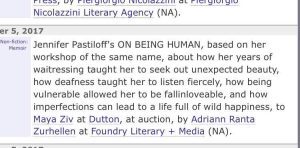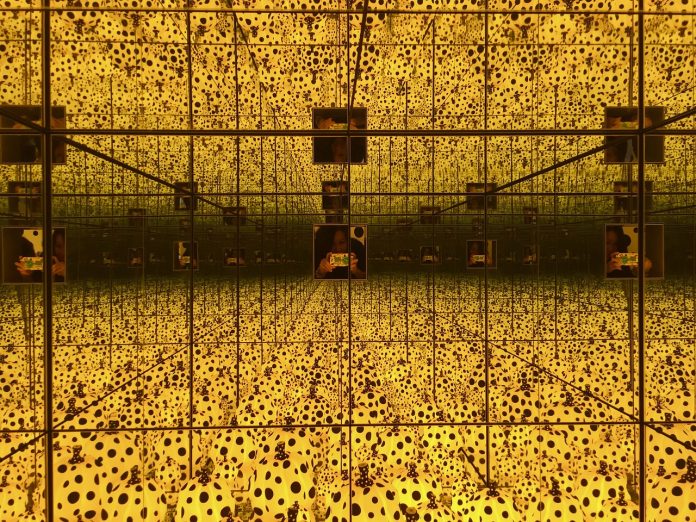By Avery Guess
- Morse Code
Morse Code is made up of dots and dashes, or more accurately, dits and dahs, but I don’t know anyone who uses the latter. I never could listen to Morse Code and understand anything beyond the standard S.O.S., and even then, I’d worry that I hadn’t heard the message correctly. My first name, Avery, is made up of a total of 8 dots and 6 dashes. My last name, Guess, 10 dots and 3 dashes. Anxiety has 8 dots and 8 dashes. Depression contains a whopping 17 dots and only 8 dashes. Bipolar disorder, 27 dots and 16 dashes. Except in the case of anxiety, the dots prevail. There is no escaping them.
- “Repetitive Vision”
I saw Yayoi Kusama’s “Infinity Room” titled “Repetitive Vision” in Pittsburgh’s Mattress Factory in August 2014 while visiting Katie, a friend I’d met on Facebook a few years before. If I had heard of Yayoi Kusama prior to seeing her work that day, it was only in passing. Kusama is a Japanese artist who has been active since the 1950s. When she is not working in her studio in Japan or overseeing her popular installations, she lives in a mental hospital a couple of blocks away. She has experienced hallucinations from an early age that appear as “flashes of light, auras, or dense fields of dots.” When Katie and I walked into the room, and the door we entered through closed behind us, I experienced the exact opposite of claustrophobia. The walls and ceiling are made up of mirrors. The floor is white and scattered large neon coquelicot polka dots. These reddish-orangish dots also cover the three white mannequins with grey wigs who stand in various poses within the room. The effect the mirrors creates is that of infinite repetition. Katie and I stood amongst the mannequins and began imitating their poses, walked around the box we were inside trying to find an end, and took photos of ourselves within this magical environment. I could have stayed for hours.
3. Interlude I: Yayoi Kusama
a. “My life’s a dot lost among thousands of dots.”
b. “When I create my work, I’m not forcing to bring the polka dots into it. Subconsciously, it became polka-dots always by itself.”
c. “After all, well, moon is a polka dot, sun is a polka dot, and then, the earth where we live is also a polka dot.”
4. Dots and Holes
Dots and holes. What is the difference? Dots occupy space, holes exist outside of space. Some people are trypophobic – random or regular clusters of holes disturb them. Are they equally made upset by patterns of dots? And why do we see dots instead of holes? Is it because dots seem to cover something while holes reveal the unseen? The dictionary defines dot as “a small round mark or spot.” Hole is first defined as “a hollow place in a solid body or surface,” but a secondary, informal definition of hole is “a small or unpleasant place” or “an awkward situation.” A hole, it seems, has more to overcome than a simple dot.
- O.S.
Every day I take medications that are meant to keep my anxiety and bipolar disorder under control. Three of the pills I take, Clonazepam (more commonly known under its brand name Klonopin), for anxiety; Trazadone hydrochloride, for sleep; and Latuda, for bipolar disorder, are circular. But, like Morse Code, my mental health is not just made up of these dots. Two of the pills I take, Depakote, for bipolar disorder, and Prazosin, for PTSD-related nightmares, are shaped closer to dashes, though they are really both more accurately described as ovals. Until recently, I was taking Vistaril, another anti-anxiety drug. If I was still taking that last pill, I could accurately portray the three dots, three dashes, and three dots that make up that well-known call for help, S.O.S. with my daily medications.
- Interlude II: Yayoi Kusama
a. “With just one polka dot, nothing can be achieved.”
b. “Polka dots can’t stay alone. When we obliterate nature and our bodies with polka dots, we become part of the unity of our environments.”
c. “If there’s a cat, I obliterate it by putting polka dot stickers on it. I obliterate a horse by putting polka dot stickers on it. And I obliterated myself by putting the same polka dot stickers on myself.”
7. ECT
In March 2017, I decided to complete a series of ECT (electroconvulsive therapy) treatments after all other attempts to alleviate my depression had failed. I had tried therapy and just about every drug that was on the market. Sometimes I would get some relief, but more often than not, I just got bad side effects from the medications my psychiatrists prescribed. My choice to try ECT was made from desperation while I was in the hospital. I can’t remember how many sessions I had. More than 10 and less than 15, I think. The procedure is quite simple and painless. General anesthesia is used so the mild seizure induced in the patient is not felt. Memory loss is a common side effect of ECT. In bilateral ECT, round electrodes are placed on either side of the temples or the forehead. In this way, I too, have obliterated myself with polka dots.
- Pointillism
In the late 1800s, the Pointillists, branching off from the Impressionists, showed viewers that the world, when viewed a particular way, is made up of dots. Growing up in the 1970s, I saw an episode of a show on PBS that discussed the pointillists, likely showing off George Seurat’s 1884 painting, “A Sunday Afternoon on the Island of La Grande Jatte,” probably the most famous piece of pointillist art, the original of which is housed at The Art Institute of Chicago. When I saw it in 2006, the show’s tag line on Seurat surfaced from my memory well: “Seurat knew a lot about dots.”
- Memory Holes
I often find myself telling people I have a terrible memory. I mean that in two ways: 1/ I don’t remember anything well, and 2/ What I often remember are the terrible things that have happened. Even prior to the retrograde amnesia caused by ECT which dates back approximately one year from my treatments, I had major holes in my memory. Once someone erased my memory—I was roofied and sexually assaulted at a business conference back when I worked as a store manager for an electronics company called Software, Etc. Only bits of that night survive. More pervasive, however, is the memory loss due to anxiety and PTSD due to the sexual, physical, verbal, and emotional abuse I endured as a child. There are entire swaths of my childhood that I don’t recall. Most of it, in fact, is just gone. There are a few memories that stand out, like those large orange dots in Kusama’s “Repetitive Vision,” but the rest are lost. This memory loss even followed me into adulthood, where, due to anxiety, I find it difficult to make memories that last.
- Total Eclipse
In August 2017, many people were focused on the total solar eclipse that was forecast to be visible across the entire continental United States. One smaller dot covering up one larger dot in a trick of science. One of the best ways to view this phenomenon if one was lacking the proper NASA approved safety glasses was to create a pinhole camera. This simple device, with its tiny hole, allows for safe viewing of a once-in-a-lifetime event. There are many ways to make a pinhole camera. One of the easiest is to cut out a small square in a sheet of cardstock, tape a piece of aluminum foil over the hole, and poke a small hole in the foil using a needle or pin. To see the eclipse, place a second of cardstock on the ground and hold the piece with foil over it with the sun to your back. The view of the eclipse should then project through the foil onto the page on the ground.
- Interlude III: Yayoi Kusama
a. “While producing art works, illusions appear from time to time due to my mental illness. Every day is a struggle for me.”
b. “Certainly, I devote my energy to both telling my personal life-story and seeking self-obliteration. However, I will not destroy myself through art.”
c. “Polka dots are fabulous.”
- (W)hole Brain
I like to think my brain after ECT as being analogous to Yayoi Kusama’s “Obliteration Rooms.” These rooms, often created to go along with a more extensive Kusama exhibit or retrospective, start out as a pure white tableau. They may be set up like a living room in which every object has been painted white. Guests are then given a sheet of dotted stickers in many colors and are invited to place dots wherever they would like. Some people embrace the chaos and place the dots randomly. Others try to form a cohesive narrative from white space and multi-colored dots. By the end of the exhibit, the dots have entirely obliterated the white space. In my case, ECT wiped my mind, painting white over everything. Day by day, though, as new memories are made, those in between spaces grow smaller. The memory loss is still there—just as the white paint still lies underneath all those dots—but as I make new memories, the white space recedes further and further into the background.


